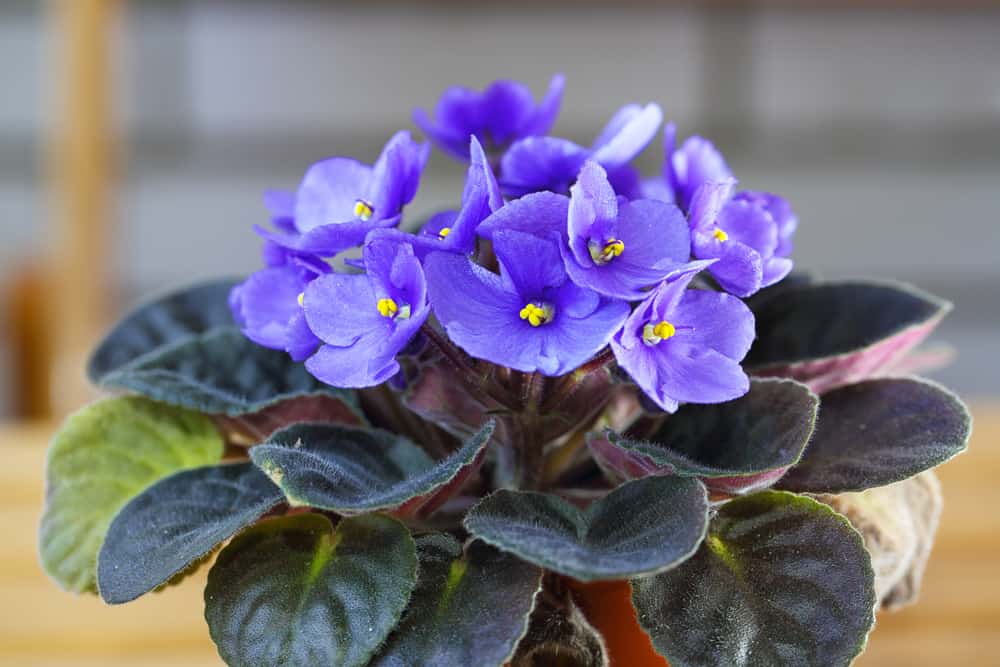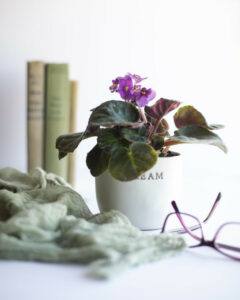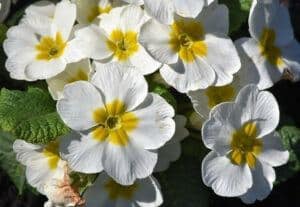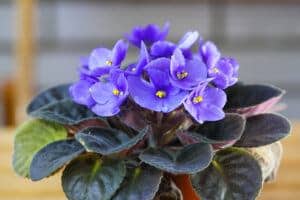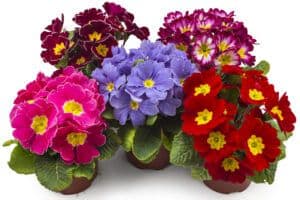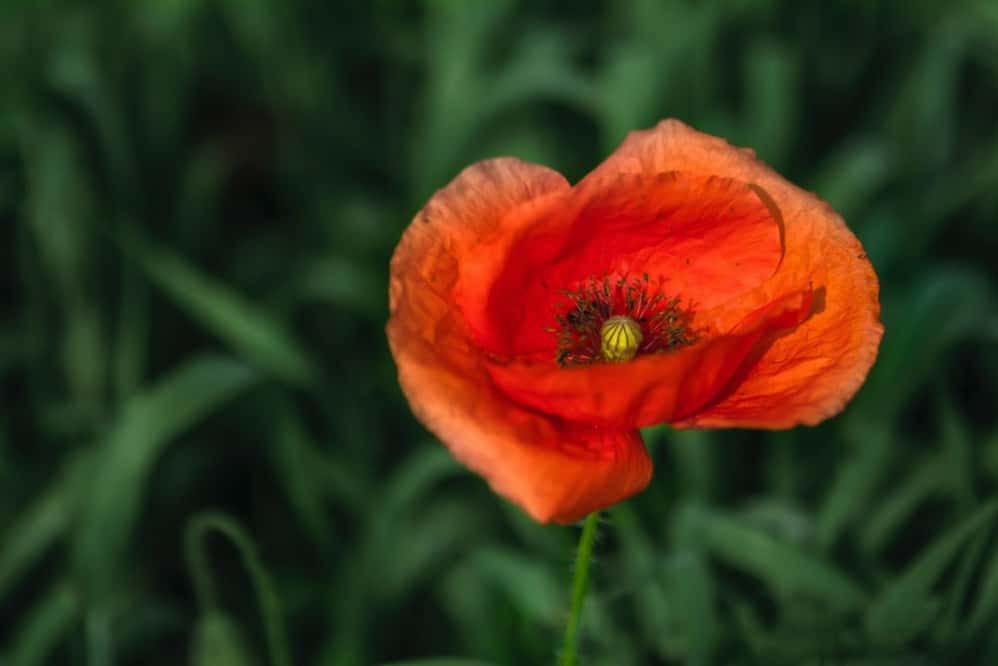HousePlantJoy is supported by our audience. When you purchase through one of our links, we may earn a small affiliate commission. As an Amazon Associate I earn from qualifying purchases. Your cost is not affected.
==================
Discover the February Birth Month Flowers
Continuing our series on these special flowers, today let’s discover the February Birth Month Flowers. Much like birth month gems, also known as birthstones, each month hosts its own birth month flowers. While purely symbolic, these beautiful flowers bring special meaning for many.
My dear Grandma loved her African Violet houseplants. I’m not sure if she knew they also symbolized her February birthday, but her home was shared with a variety of these plants in white, purple, and pink petals.
Today, more and more, people choose to symbolize the birth month with flowers rather than gemstones. In that way, they share the love with everyone entering the home. And houseplants create a living tribute to our parents who born and raised us.
Looking for a gift for that special someone with a February birthday? Consider these very special February Birth Month Flowers. A gift of houseplants lasts much longer than that box of chocolates for Valentine’s Day, too!
Why birth month flowers?
People used flowers to connect long before email, texting, instant messaging, or even phone calls. In the 18th and 19th centuries, the language of flowers, also known as Floriography, became more widespread. Gifting flowers to a loved one or bringing to a host seemed normal and almost necessary.
Of course, today our world offers many more options for connecting and gift-giving. But flowers still hold a special appeal. And houseplants show a personal touch.
Meet the February birth month flowers
The violet and Primrose are February birth month flowers. Because February is always associated with Valentine’s Day, when they learn that roses are not the month’s official birth flower, it still surprises people.
A sign of humility, faithfulness, and virtue is this purple violet indoor flower. A gift of violets was a declaration to always be real in the Victorian period. However, and it still serves as a beautiful reminder of fidelity, care, and reliability.
The primrose, a pale-yellow perennial with European origins, is sometimes cited as the February month birth flower. Primroses symbolize young love, so for a significant other, they are a perfect gift.
-
Violet indoor flowers
Violets, the February birth month flowers, talk of the most tender beauty and infinite grace. If your lovers are born in February, honor them with the gift of celebrating their day with a bunch of violets.
Violets are a ubiquitous flower with over 500 species. The two primary kinds of flowers known as violets are:
- The real violets
- Violets from Africa.
Violets have been around for a very long time. Historians know that the Ancient Greeks grew violets around 500 BCE. They made use of them for the wine they called Vinum Violated. They also used violets as herbal medicine and as an ingredient in love potions to sweeten foods.
However, in many classic stories, violets also have a location. The goddess Venus transformed maidens into blue violets in a Roman myth because she was jealous of their beauty.
What does violet symbolize?
Throughout human history, violets have borne several meanings:
- They represent modesty and dedication when associated with Mary.
- They were used as a sign of remembrance by the early Romans and brought to funerals.
- Innocence, faith, inspiration, security, spirituality, and abundance can also mean violets.
- They use as symbols of a love so great in many stories that violets rose spontaneously to mark the spot where a genuine love died.
- The ancient Greeks considered violets as a sign of fertility and love.
How to grow violet indoors?
In North America, African violets are strictly indoor species, primarily because their leaves need to remain dry. Develop plants in clear, indirect light for the best color. Moreover, for perfect growth and blooms, place the plant three feet away from the west or south-facing window.
Moreover, if you don’t have the right spot near a window, therefore, you can grow African violets 12 to 15 inches above the plant under 40-watt fluorescent lights (or grow lights).
How to care for violet indoor flowers?
African Violets have the kind of beauty that cheers up the world and makes you smile with their beautifully shaped fuzzy leaves. Here are some reliable tips if you are new to growing African violets at home. Moreover, or you want to learn more about keeping them safe and flourishing.
- Water
There are several thoughts on African water violets, ensuring that the soil is kept moist to the touch. However, never soaked or sodden is an essential guideline. Try not to spill some water on the leaves that will get spotty from the water if you water by hand. You may water from the bottom up, which will help you prevent the potted plant’s appearance.
- Natural light
Instead of direct sunlight, African violets need indirect light, which can burn their leaves. By times there is plenty of indirect sunlight for them to absorb; they are ideal windowsill plants. The best time of light for the plant is 10-14 hours of the morning and eight hours of darkness. Moreover, the best position for optimum flowering is windowsills that face east or west.
- Humidity
Violets need a humid atmosphere, with more humidity than most home plants need. Suppose the bottom-up watering device use your violet houseplant will already have the value of this moisture-generating process. Another right way is to keep the plants on pebble dishes or trays that are kept moist.
- Feeding
Violets do not need a lot of fertilizer. However, over-fertilized, too much, or too little fertilizer may produce lots of green leaves but very few flowers. Use a fertilizer designed explicitly for violets, and do not overdo it if you find that your plant does not flourish or bloom very much.
- Container
All potted plants and violets are no exception, should be planted in containers with suitable drainage holes. To prevent rotting, proper drainage is necessary. However, if you cannot survive without a hole-less ceramic pot, place the plant in a plastic container with drainage holes. Moreover, and put the box inside the ceramic one.
- Soil
Again, to keep your African violet safe, drainage is necessary, so use a commercial mix of sterile potting soil and perlite. If you need to report, make sure you use a clean potting mix.
- Environment
African violets are intended for year-round cultivation indoors. While some gardeners take them out when the temperatures are mild, they are prone to insect damage. Moreover, when kept indoors, they will stay healthier and prettier.
-
Propagation
In their pots, violets like to be a little root-bound, and this is when they create offspring that can become new plants.
Remove the entire plant when you see new crowns have grown in the pot. Moreover, you can gently separate the new growth and place it in its jar. You may also cut and root a leaf from the plant in water, ensuring that the water does not submerge the leaf.
Violet flowers as a gift
Consider offering violets to your loved one for their February birthday. They’re lovely, different, and a lot of them have an enticing sweet fragrance.
For their special day, here are a few ideas.
- To remind you of your love for months or even years, give them a potted African violet.
- Create a mixed bouquet with the two flowers of devotion, violets, and roses
- Select and place the wild violets in an elegant wicker basket.
-
Primrose Houseplant
However, they also leave many owners wondering how to grow indoor primrose. If you would like this lovely plant to thrive, Primrose indoor care is vital.
Primrose flowers, when offered to lovers, are beautiful flowers. Giving a primrose flower to your beloved will convince him or her that you cannot live with them.
What does primrose symbolize?
- In addition to this flower’s relation to youth and longevity, it has several other meanings, too.
- Primrose flowers can use as depictions of youthful love and the thought that you can’t survive without your lover.
- Primrose flowers are also sometimes used as holistic representations of femininity.
- For all the different phases of life, including birth, life itself, consummation, and, of course, death, the petals on the blossoms should stand.
- These flowers may stand for overlooked merit, inconstancy, and even bashfulness
- But they are generally given to show someone that without them, you can’t live.
Primrose houseplant care
These flowers can be very delicate and need special care to look their best and flower the longest. To keep your potted primrose profusely lush, colorful, and blooming, here are few tips.
- Light
They need bright light indoors. These plants are called indoor plants with “high light.” By positioning them in front of an east-facing window, their light needs can fulfill. Brief periods of direct, cool morning sun with clear, indirect light will enable them to bloom throughout the day.
Their light needs can also fulfill by positioning them directly in front of a south-facing window. However, make sure a sheer curtain between the primrose and the window.
When they finish blooming, move them outdoors to a full-shade area if necessary and bring them back indoors in the fall.
- Water
Keep uniformly damp but not excessively wet the potting soil. Enable to start drying the top surface of the potting soil before watering. Primrose plants are shallow-rooted, and the bottom of the container will not be able to obtain moisture.
It is too dry if the soil dries down to a depth of 1/2 inch. Do not account for the dryness of the earth. There should be holes in the bottom of the container so that the water drains quickly. Moreover, if there is a catch saucer underneath the box, clear the water that drains into it.
- Temperature and humidity
Since these are cooler-temperature-adapted northern flowers, they do well at room temperatures of 50-70 degrees. They will wilt in higher temperatures, and the blooms will disappear more rapidly.
A high-humidity climate also likes these flowers. It is beneficial to use a room humidifier nearby your houseplant. Moreover, place the pot on a wet pebble tray to add more water to the air. Grouping together many plants would also increase their immediate humidity.
- Fertilizer
Every two to four weeks, give the primrose a healthy, water-soluble houseplant fertilizer, such in fall, winter, and spring. At a pace of 1 tablespoon for each 1 gallon of water, water-soluble houseplant fertilizer is sometimes dilute. However, this varies depending on the fertilizer’s formula and strength.
The dilution rate for primrose plants should be one-half of the rate recommended by the manufacturer. For each use, blend the fresh fertilizer. Avoid fertilizing after the primrose stops blooming in summer. However, this is the natural dormant season of the primrose.
- Choose the right pot
A compact pot can make them feel more relaxed since these are smaller plants. If you want to keep the soil moist, plastic or glazed pots hold water better. However, but a drainage hole is necessary to lower the risk of root rot.
- Repotting
Report primrose plants every year or two in spring or fall. When they become pot-bound, they do not grow well. Just one size larger should be the current container and should have drainage holes. Larger primrose plants can divide into many plants that have surpassed the width of their container.
- Pinch to encourage reblooming
As they mature, primrose blooms will gradually darken, and pinching off the oldest, darkest flowers will stimulate more frequent reblooming and lengthen the plant’s flowering lifetime. However, pinch gently to avoid undue damage.
Conclusion
Like the birthstones, there are also flowers related to every month. Likewise, there are also February birth month flowers. Violet and primrose are the two February birth month flowers. Spice up Valentine’s Day with a flower of birth like violets that reflects fidelity and faithfulness. If those aren’t your thing, check out primroses, which you can give to someone you can’t imagine your life without them.
However, there is also a need for proper care for these indoor plants. Try to apply all the tips for proper care of these houseplants so that they bloom well.
Read More
African Violets
Primrose Flowers

